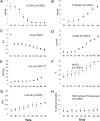Evolution of adverse changes in stored RBCs
- PMID: 17940021
- PMCID: PMC2040393
- DOI: 10.1073/pnas.0708160104
Evolution of adverse changes in stored RBCs
Abstract
Recent studies have underscored questions about the balance of risk and benefit of RBC transfusion. A better understanding of the nature and timing of molecular and functional changes in stored RBCs may provide strategies to improve the balance of benefit and risk of RBC transfusion. We analyzed changes occurring during RBC storage focusing on RBC deformability, RBC-dependent vasoregulatory function, and S-nitrosohemoglobin (SNO-Hb), through which hemoglobin (Hb) O(2) desaturation is coupled to regional increases in blood flow in vivo (hypoxic vasodilation). Five hundred ml of blood from each of 15 healthy volunteers was processed into leukofiltered, additive solution 3-exposed RBCs and stored at 1-6 degrees C according to AABB standards. Blood was subjected to 26 assays at 0, 3, 8, 24 and 96 h, and at 1, 2, 3, 4, and 6 weeks. RBC SNO-Hb decreased rapidly (1.2 x 10(-4) at 3 h vs. 6.5 x 10(-4) (fresh) mol S-nitrosothiol (SNO)/mol Hb tetramer (P = 0.032, mercuric-displaced photolysis-chemiluminescence assay), and remained low over the 42-day period. The decline was corroborated by using the carbon monoxide-saturated copper-cysteine assay [3.0 x 10(-5) at 3 h vs. 9.0 x 10(-5) (fresh) mol SNO/mol Hb]. In parallel, vasodilation by stored RBCs was significantly depressed. RBC deformability assayed at a physiological shear stress decreased gradually over the 42-day period (P < 0.001). Time courses vary for several storage-induced defects that might account for recent observations linking blood transfusion with adverse outcomes. Of clinical concern is that SNO levels, and their physiological correlate, RBC-dependent vasodilation, become depressed soon after collection, suggesting that even "fresh" blood may have developed adverse biological characteristics.
Conflict of interest statement
Conflict of interest statement: E.B.-G., A.D., M.J.T., T.L.O., and T.J.M. received grant support from NITROX LLC (
Figures




Comment in
-
Clinical implications of the loss of vasoactive nitric oxide during red blood cell storage.Proc Natl Acad Sci U S A. 2007 Dec 4;104(49):19165-6. doi: 10.1073/pnas.0708871105. Epub 2007 Nov 28. Proc Natl Acad Sci U S A. 2007. PMID: 18048331 Free PMC article. No abstract available.
References
-
- Whitaker BI, Henry R. 2005 Nationwide Blood Collection and Utilization Survey Report. Washington, DC: National Blood Data Resource Center, US Department of Health and Human Services; 2005.
-
- Tinmouth A, Fergusson D, Yee IC, Hebert PC. Transfusion. 2006;46:2014–2027. - PubMed
-
- Leal-Noval SR, Jara-Lopez I, Garcia-Garmendia JL, Marin-Niebla A, Herruzo-Aviles A, Camacho-Larana P, Loscertales J. Anesthesiology. 2003;98:815–822. - PubMed
-
- Purdy FR, Tweeddale MG, Merrick PM. Can J Anaesth. 1997;44:1256–1261. - PubMed
-
- Zallen G, Offner PJ, Moore EE, Blackwell J, Ciesla DJ, Gabriel J, Denny C, Silliman CC. Am J Surg. 1999;178:570–572. - PubMed
Publication types
MeSH terms
Substances
LinkOut - more resources
Full Text Sources
Other Literature Sources
Medical

